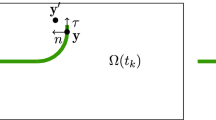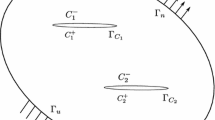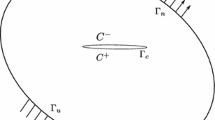Abstract
We propose a mathematical model of the fatigue growth of a plane crack in a three-dimensional body based on the best least-squares approximation of its moving contour by an ellipse. Unlike the traditional scheme, we use five parameters to characterize the location, orientation, and size of this ellipse. Differential relations for determining these parameters are obtained by considering the displacements of all points of the contour (treated equivalently) caused by crack growth.
Similar content being viewed by others
References
ASME Boiler and Pressure Vessel Code, Section 11, New York (1986).
A. V. Ovchinnikov, A. A. Popov, and G. S. Vasil'chenko, “Calculation of structural elements with discontinuities on the basis of nondestructive testing data,”Probl. Prochn., No. 9, 74–79 (1988).
Fracture Mechanics and Strength of Materials: Handbook [in Russian]: Vol. 2: M. P. Savruk,Stress Intensity Coefficients in Bodies with Cracks, Naukova Dumka, Kiev (1988).
Y. Ito, Y. Murakami, N. Hasebe, et al.,Handbook of Stress Intensity Coefficients [Russian translation], Mir, Moscow (1990).
Additional information
Karpenko Physicomechanical Institute, Ukrainian Academy of Sciences, L'viv. Translated from Fiziko-Khimicheskaya Mekhanika Materialov, Vol. 29, No. 5, pp. 52–56, September–October, 1993.
Rights and permissions
About this article
Cite this article
Andreikiv, O.E., Darchuk, O.I. Investigation of plane crack growth in a three-dimensional body. Mater Sci 29, 485–489 (1994). https://doi.org/10.1007/BF00558769
Received:
Issue Date:
DOI: https://doi.org/10.1007/BF00558769




